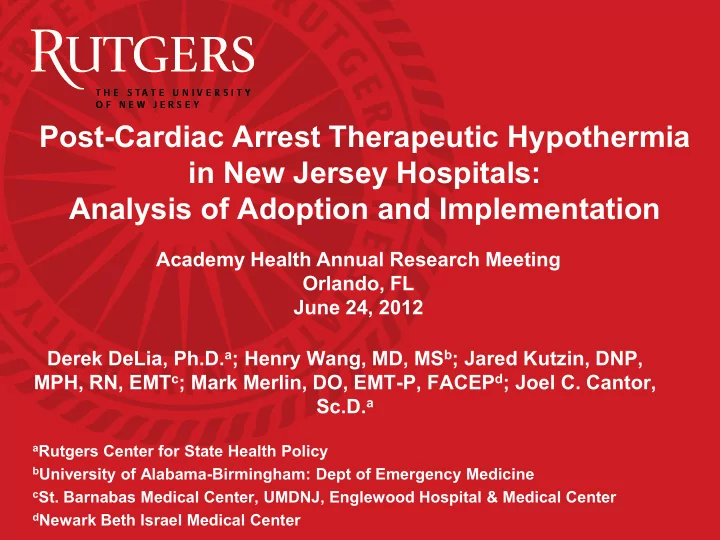

Post-Cardiac Arrest Therapeutic Hypothermia in New Jersey Hospitals: Analysis of Adoption and Implementation Academy Health Annual Research Meeting Orlando, FL June 24, 2012 Derek DeLia, Ph.D. a ; Henry Wang, MD, MS b ; Jared Kutzin, DNP, MPH, RN, EMT c ; Mark Merlin, DO, EMT-P, FACEP d ; Joel C. Cantor, Sc.D. a a Rutgers Center for State Health Policy b University of Alabama-Birmingham: Dept of Emergency Medicine c St. Barnabas Medical Center, UMDNJ, Englewood Hospital & Medical Center d Newark Beth Israel Medical Center
Acknowledgements This research was supported by the Agency for Healthcare Research & Quality (Grant no. R01-HS020097-01) Assistance from Manisha Agrawal, Nicole DeMola, and Ayesha Aslam Center for State Health Policy 2
Therapeutic hypothermia (TH) • Fairly new & innovative treatment for out-of-hospital cardiac arrest (OHCA) – Reduce body temperature during post-arrest treatment – Improve survival & neurological outcomes • TH now recommended treatment for OHCA – International Liaison Committee on Resuscitation, 2005 – American Heart Association, 2010 • But TH is not universally used – Difficult to set up & maintain TH capability – Doubts about (limited) evidence base Center for State Health Policy 3
Our project (overall) Aim 1: Create linked database for NJ Prehospital EMS (EHRs) Hospital billing records Mortality records Aim 2: Conduct CER study of TH vs. non-TH OHCA care • Coding of TH in hospital billing records – ICD-9-CM code exists – No reimbursement consequences – Likely under/no reporting • We conducted a survey of TH use by NJ hospitals • Today’s presentation reports on survey results Center for State Health Policy 4
Survey of NJ hospitals • Fielded in Summer 2011 • Brief telephone survey (5-10 minutes) – ED nurse manager (or similar position) – TH use, protocols, related issues – Written protocols if available • Fallback: 90-second version Center for State Health Policy 5
Participation • Universe = 73 acute care hospitals • 54 full interviews • 19 brief (fallback) interviews • 18 written protocols (21 hospitals) Center for State Health Policy 6
NJ hospitals providing TH, Summer 2011 68.4% 17.8% 13.7% Currently providing TH Plan to provide TH Not providing TH & no plans Based on 73 acute care hospitals in all NJ hospitals Center for State Health Policy 7
Growth in # NJ hospitals providing TH 4 7* 38 24 7 4 2 1 0 2004 2005 2006 2007 2008 2009 2010 2011 * 3 additional hospitals provided TH in 2011 but could not report how long the Center for State Health Policy 8 TH program had been in place. Therefore, 2011 total is 50.
TH provision by annual OHCA volume 70% 60% 50% 40% 30% 20% 10% 0% ≤ 12 13-36 37-60 61-120 ≥ 121 Providing TH Plan to provide Not providing Based on 54 hospitals w/full survey data. Center for State Health Policy 9 Percentages sum to 100 within colored bars.
TH provision & other hospital characteristics • Little or no difference by … – Teaching status – Patient volume – Occupancy rate Center for State Health Policy 10
Exclusion criteria: Patient characteristics 17.9% of TH hospitals exclude 81.6% based on all 8 conditions asked. 71.8% 71.1% 68.4% 62.2% 55.6% 50.0% 44.7% 41.7% Center for State Health Policy 11 Based on 39 TH hospitals w/full survey data.
Inclusion criteria: ECG rhythms 91.9% 51.3% of TH hospitals provide TH 89.2% for all 4 rhythms. 71.1% 65.8% VT VF PEA Asystole Center for State Health Policy 12 Based on 39 TH hospitals w/full survey data.
Cooling methods 35.9% of TH hospitals coordinate 80.0% 74.4% cooling w/prehospital EMS. 59.0% 51.3% 28.9% 2.6% Specialized I/V fluids Cold packs Blankets Endovascular Others systems catheter Center for State Health Policy 13 Based on 39 TH hospitals w/full survey data.
Written protocols • Large variation in … – Duration of TH – Defined start of duration time – Time to reach target temperature – Re-warming time – Measurement & response to patient shivering • Large variation in protocol details – Level of detail – What gets mentioned Center for State Health Policy 14
Summary • Most NJ hospitals implementing TH guidelines • Large variation in the way guidelines are implemented • TH centers often see very low volume of OHCA patients – TH volume even smaller given patient exclusions • > 1/3 of TH centers coordinate patient cooling in prehospital setting Center for State Health Policy 15
Implications • Variation in TH practice – Does it affect patient outcomes? – What does it mean to follow practice guidelines? • Patient selection criteria ==> access disparities? • Low TH volume & quality of care – Prior research ==> better outcomes if annual OHCA cases ≥ 40 • Factors that determine adoption of TH guidelines not well understood – Reputation/marketing, peer influence? Center for State Health Policy 16
For more information … D. DeLia, H. Wang, J. Kutzin, M. Merlin, & J.C. Cantor (2012), “Post Cardiac Arrest Therapeutic Hypothermia in New Jersey Hospitals: Analysis of Adoption and Implementation.” Forthcoming in Therapeutic Hypothermia and Temperature Management . D. DeLia: ddelia@ifh.rutgers.edu Center for State Health Policy 17
Recommend
More recommend